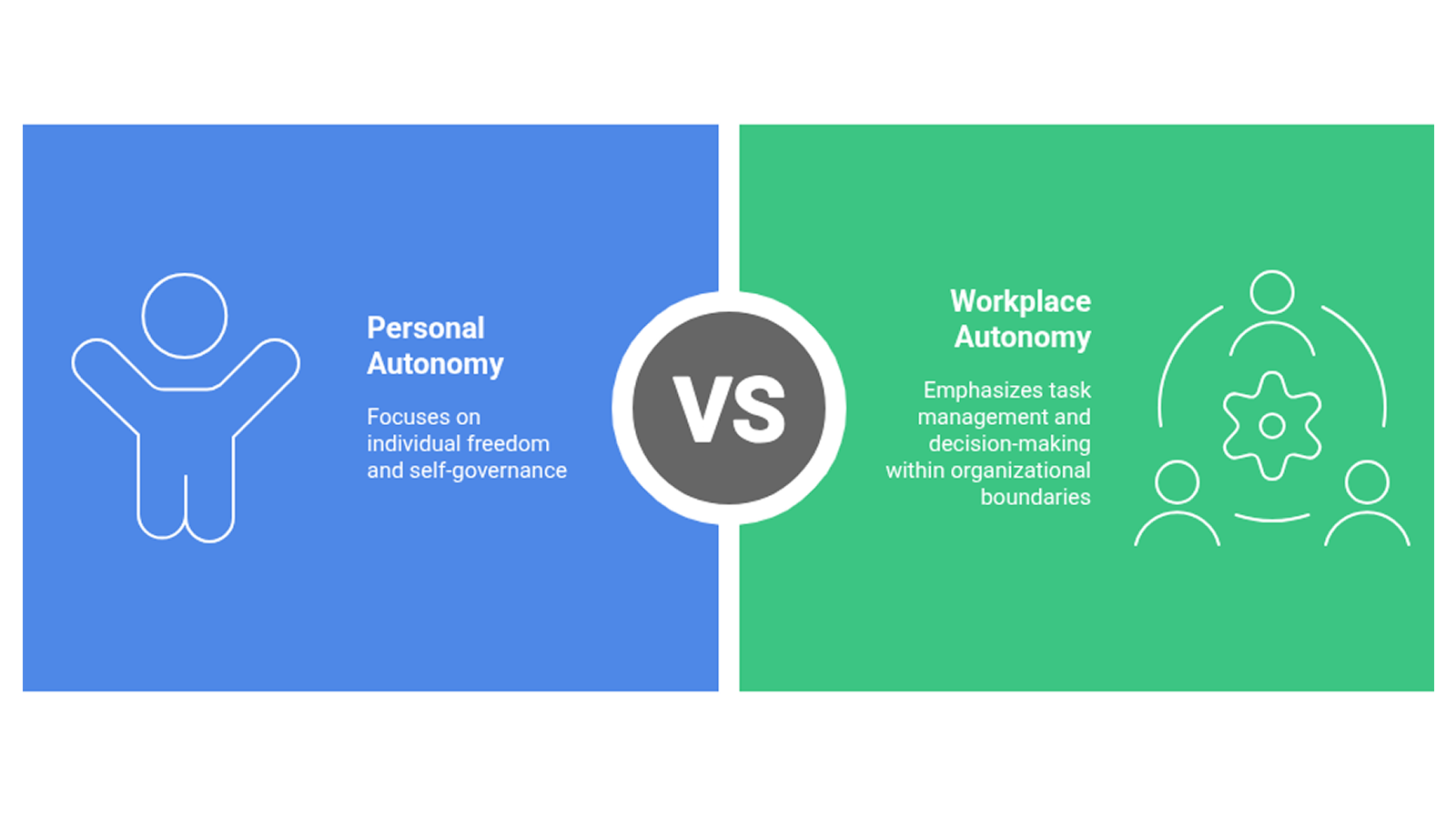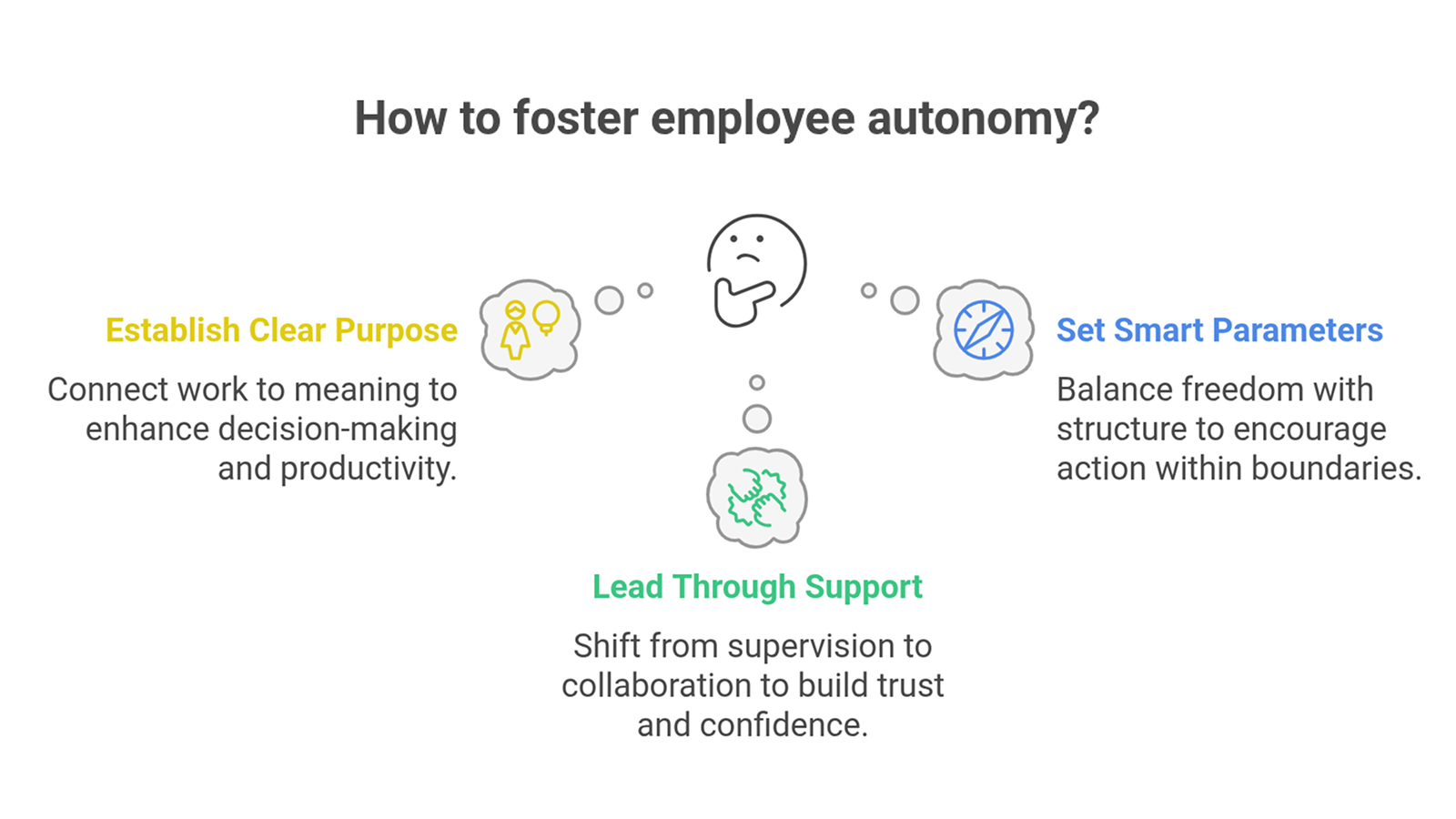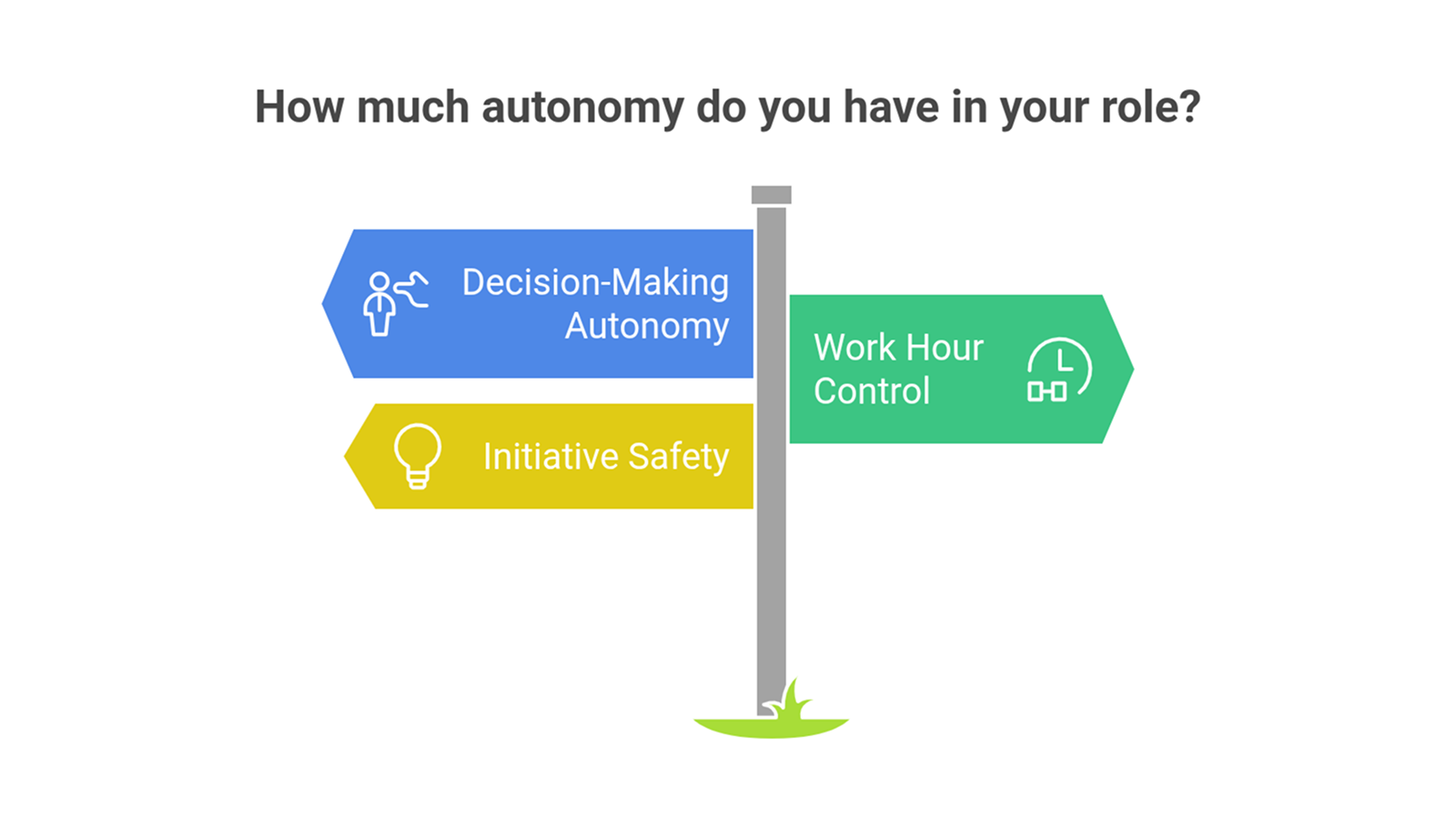Balancing structure and autonomy is a major leadership challenge in today’s fast-paced workplace. Yet when done right, autonomous work boosts ownership, employee engagement, and innovation, while reducing burnout. Still, many leaders hesitate, fearing a loss of control — but that fear is costly: according to Effectory, 52% of employees lack autonomy, while 79% of those who feel autonomous are highly engaged.

This guide unpacks the value of autonomy and shows how aligning freedom with structure can drive professional development and higher levels of job satisfaction.
What Does Autonomy Mean in the Workplace?
Imagine a football team: players know their roles, but once the game begins, they read the field, make quick calls, and trust each other. That’s autonomy in the work environment — employees act independently within shared goals and values.

Autonomy at work isn’t the same as personal autonomy. It’s about giving employees the freedom to manage tasks and make decisions within clear organizational boundaries. The key is to provide employees with structure, trust, and the tools they need to take ownership and have greater control over their work.
“Control leads to compliance; autonomy leads to engagement.”
— Daniel H. Pink
The Benefits of Autonomy at Work
Employee autonomy is a game-changer — it delivers real results for both people and organizations. When employees have the freedom to work autonomously, three big wins rise to the surface:
1. Motivation
Freedom to make decisions lights an internal fire. People stop just checking boxes and start solving problems — they’re all in, personally invested and building new skills as they manage their work.
2. Innovation
When the workforce is trusted to take initiative, ideas flow. A culture that encourages autonomy becomes a launchpad for creativity, where experimenting is the norm and smart risks are part of the game plan. According to research by McKinsey & Company, companies that harness the essentials of innovation achieve economic profit 2.4 times higher than their peers.
3. Retention
Job autonomy plays a big role in helping people perform at their best. It leads to increased job satisfaction, productivity, and better work-life balance — all of which are essential for keeping great employees around. Nearly half of workers say they’d trade a 20% raise just for more control over how they work. That says a lot: when organizations prioritize autonomy, they don’t just attract talent — they build loyalty and reduce turnover.

What managers need to remember:
Autonomy isn’t about removing structure — it’s about setting clear goals that allow employees the freedom to choose how to reach them. Giving people the chance to make their own decisions helps them feel empowered, engaged, and committed — turning autonomy into a real competitive advantage.
What Happens with a Lack of Autonomy at Work
Lack of autonomy is a fast track to micromanagement, low trust, and people heading for the exit. According to Trinity Solutions, 71% say micromanagement hurts performance, 85% feel their morale drop, and 36% actually walk away — while 69% seriously think about it. If employees don’t have enough freedom to do their job, creativity drops, burnout rises, and top talent starts looking elsewhere.
Before vs. After: Autonomy in Action
| Aspect | Micromanaged | Autonomous |
| Decision-making | Centralized, slow | Distributed, agile |
| Innovation | Limited | Emergent from empowered teams |
| Communication | Top-down | Open and multi-directional |
| Employee experience | Frustrated and disengaged | Motivated and fulfilled |
| Turnover | High | Lower |
| Response to challenges | Delayed by approvals | Fast and proactive |
| Trust levels | Low, control-based | High, outcome-focused |
A study in the Journal of Applied Psychology found that employees with high workplace autonomy reported 47% greater job satisfaction.
Examples of Autonomy in the Workplace
Autonomy in the workplace takes shape through everyday decisions. A sales rep who sets their own outreach schedule, or a designer who chooses their tools, works with more creativity and ownership. These choices tap into individual strengths and foster better results. Gallup found that employees who help set their own goals are 3.6× more engaged at work.
Remote teams rely on autonomy even more. With asynchronous choices, employees can act without delays, especially across time zones. Trust and clarity replace control, boosting agility and accountability.
At Buffer, empowered autonomy is central to how teams work. Even as the company grew, it maintained a culture of trust through "empowered accountability." Support team members are encouraged to make customer-facing decisions, collaborate with product and engineering, mentor peers, and shape their own growth. This leadership approach removes hesitation around decision-making and boosts engagement, ownership, and long-term commitment.
How to Increase Employee Autonomy Without Losing Control
Fostering autonomy in the workplace doesn’t mean removing structure — it means redefining it. The 3P Framework — Purpose, Parameters, Partnership — helps leaders empower employees while keeping alignment and clarity. Employees need more than freedom — granting autonomy without direction turns into chaos.

1. Purpose: Connect Work to Meaning
To build employee autonomy, start with a clear purpose. When people see how their work fits into bigger goals, they make better decisions. Clarity drives productive work — and benefits everyone.
2. Parameters: Set Boundaries, Not Rules
The best type of management balances freedom with structure. Autonomy works best within clear limits — not rigid rules, but smart parameters like decision rights, budget caps, deadlines, and non-negotiables. It’s about creating space to act while treating failures as learning opportunities, not setbacks.
3. Partnership: Lead Through Support
Shift from supervision to collaboration. Leaders shouldn’t micromanage — their role is to guide, support, and create psychological safety. Let employees take initiative, even when the results aren’t perfect. Autonomy in the workplace shows when people feel trusted and confident making decisions in their work life. That’s how autonomy in their work truly grows.

Checklist: Is Your Team Autonomy-Ready?
- Purpose is linked to outcomes
- There’s clarity on who owns which decisions
- Employees have right tools and resources
- Coaching builds independence
- Successes and lessons are shared
- Initiative is recognized
- Metrics focus on outcomes, not just process
- Leadership communicates trust consistently
How to Create a Culture of Autonomy
A real culture of autonomy comes from the top — it’s baked into company policies and values, not just left to individual managers. Flexible schedules, self-directed projects, and open communication all signal that autonomy in the workplace is encouraged and expected. This kind of workplace culture provides employees with freedom to make decisions and builds a foundation of trust.
Cultural rituals help keep that mindset alive. Innovation days, peer shout-outs, and trust-first policies show faith in employee judgment and boost employee motivation, ownership, and psychological safety. This kind of autonomous work environment fuels increased creativity, as people feel safe to experiment and take the lead.
To keep encouraging autonomy in the workplace, tie it to growth. Support mobility, self-driven learning, and tools like Asana, Notion, or Slack that support autonomous work. These systems ensure employees have what they need to do great work — just like Buffer, where the impact on employee success speaks for itself.
Common Pitfalls When Building an Autonomous Culture
- No clear goals = misalignment
- Uneven autonomy across teams
- Autonomy “theater” (freedom in name only)
- Lack of accountability systems
- No training for decision-making
- Rewards tied to compliance, not initiative
- Pulling back trust after one mistake
- Employees left out of the loop when making decisions
How to Measure Autonomy in the Workplace
Measuring work autonomy takes more than just checking satisfaction boxes — it’s about understanding autonomy within daily work: how much ownership, independent judgment, and real impact people have. Combine surveys with smart KPIs to spot gaps and track progress over time.

Good survey templates dig into actual behavior and mindset. Ask things like:
- How often do you make decisions without needing approval?
- Do you control your work hours and priorities?
- Do you feel safe taking initiative or making mistakes?
Don’t just focus on freedom — include questions around empowerment, psychological safety, and access to resources. That’s what drives sustainable work autonomy. Useful KPIs for measuring employee autonomy include:
- Goal Ownership Index – % of goals co-created by employees
- Initiative Index – projects launched by employees without manager input
- Decision Velocity – time from issue to resolution without escalations
Together, these paint a clearer picture of how autonomy within teams is really working.
Autonomy Maturity Model
| Level | What it Looks Like | How to Measure It |
| 1. Basic | Employees follow clear instructions and set rules | Task completion, basic productivity, rule adherence |
| 2. Moderate | Employees choose how and when to do tasks, within limits | % of time spent self-managing, number of ideas acted on |
| 3. High | Employees set priorities and make key decisions | Decisions made without needing approval, fast resolutions |
| 4. Strategic | Employees feel a sense of impact on strategy and direction | Involvement in strategic projects, new leaders emerging |
By using this model, companies can clearly see where autonomy within teams is strong — and where more support or empowerment might be needed.
Final Takeaways: Embrace Autonomy as a Competitive Advantage
Workplace autonomy isn’t just a nice-to-have anymore — it’s a real strategic advantage. Companies that empower employees to take ownership, make smart calls, and adapt on the fly leave rigid, top-down models in the dust. Simply put, autonomy enhances both speed and resilience.
Key takeaways:
- Autonomy only works well when it’s grounded in clear boundaries
- Trust is great — but it has to walk hand in hand with accountability
- Great leaders enable, guide, and get out of the way
- Highly autonomous teams don’t happen overnight — start small and build
Quick action step: Audit your autonomy setup. Ask yourself:
- Where are decisions being made?
- Who actually makes them?
- Do frontline teams have the authority their insight deserves?
When people have room to move and clarity to act, they bring their best work — and that’s where workplace autonomy truly shines.
Interactive Quiz: Which Autonomy Level Fits Your Team?
1. How does your team handle unexpected problems?
A) Escalate to management
B) Follow protocols
C) Solve creatively within guidelines
D) Redesign systems
2. How are goals set?
A) Fully assigned
B) Outcomes set, methods flexible
C) Co-created
D) Employee-driven
3. Who makes decisions?
A) Mostly managers
B) Routine = team; exceptions = escalated
C) Team, with reviews
D) Full autonomy with transparency
4. How do you approach new ideas?
A) Wait for leadership
B) Suggest within limits
C) Test and report
D) Implement independently
5. How is performance measured?
A) Process adherence
B) Outcomes
C) Stakeholder value
D) Strategic impact
Results:
- Mostly A’s: Basic Autonomy — Expand team decision-making
- Mostly B’s: Moderate Autonomy — Boost psychological safety
- Mostly C’s: High Autonomy — Involve in strategy
- Mostly D’s: Strategic Autonomy — Ensure freedom aligns with accountability







